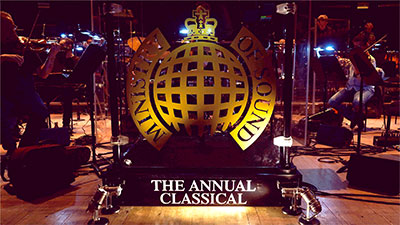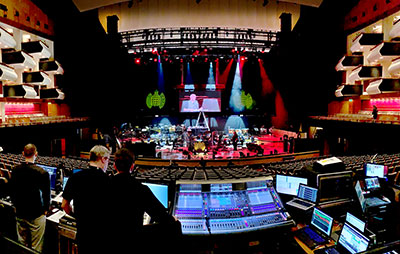Ministry of Sound The Annual Classical, a new orchestral tour received its world premiere at London’s Royal Festival Hall recently. The event celebrates the famous club’s legendary dance music compilation The Annual – the best-selling dance compilation of all time.
The live shows, mixed on a DiGiCo SD7 supplied by RG Jones, deliver huge sounds as classic hits receive a classical reworking. Among them are Chemical Brothers’ ‘Hey Boy Hey Girl’; ‘Insomnia’ by Faithless and Moloko’s ‘Sing It Back’. At the helm of the complex live mix is sound designer, Phil Wright.

‘In the past couple of years, we’ve seen all kinds of classical dance music shows take to the stage, but the design brief from MoS was to make this a genuinely live performance, meaning no playback,’ he says.
With the brief in place, a collaboration between Coalition Agency and Raymond Gubby Ltd, which runs the 55-piece London Concert Orchestra, began with British composer Tom Player producing arrangements for the orchestra.
The large-scale orchestral production called for Wright’s long-trusted mixing companion. ‘It was always going to be me and a DiGiCo console,’ he says. ‘I was thinking about an SD10, but it became obvious that I needed a bigger desk and therefore I decided on an SD7. It’s been the perfect choice and even on a console with the huge capacity of the SD7, I had only four busses and two channels not in use.’
The Annual Classical is no ordinary show, as Phil explains: ‘On stage, we have 55 people plus backing vocalists, guest singers and extensive effects. I’m running 12 FX racks in my SD7 and another six in Waves externally with my own DiGiGrid rig. It turned out to be the ideal way to do it.’
Wright has two SD-Racks on stage, taking inputs and sending outputs to a pair of Martin Audio DD6s. A total of 17 performers use personal mixers. ‘With the co
The SD7 also helped to ensure a smooth production filtered through to other departments. ‘It’s been a very close collaboration between Tom and I, and it quickly became obvious that we’d needed a click track – both for people to listen to and as a visual reference,’ Wright notes. ‘Some of the pieces were 20 minutes long and featured a mix of five or six tracks, so it’s easy to get lost without it.mpatibility, I could drive a Madi stream out of the SD7 to the personal monitoring set-ups,’ he explains. ‘I was sending 40 channels to the personal mixers, and using 16 subgroups, which was driving an extremely high aux count for this show.’
‘I worked with Tom to construct a visual click system for the show which works off my dual redundant system. The musicians received an audible click and visual reference, which I could output to the lighting and sound console. While some cues are manual, the SD7 can do some of this itself based on the timeline, which was particularly useful to our lighting department.’
The SD7 provided additional benefits: ‘With running the show from a click track system with SMPTE, I’ve been able to snapshot every music number and subdivide some of them so I can put FX on the instruments. I used the screen in the SD7 with a copy of the visual click system so I could easily follow the progress.’
Full rehearsals took place at the new Music Bank facility and the tour premiered at London’s Royal Festival Hall in late-January. ‘It was phenomenal,’ Wright reports. ‘There’s a ten-minute film introduction to the event which explains the history of the MoS club, and the history of devising The Annual Classical. As it ends, the conductor hits ‘go’ and from the first beat, the audience stood up and never sat down again. I’ve never seen a reaction like it.’
Royal Festival Hall finalé

Reproducing the newly imagined sound on the road was RG Jones’ Martin Audio MLA Compact PA. Although the concept was new, reproducing major classical music events for promoters like Raymond Gubbay is familiar territory for RG Jones Sound Engineering, who have been specialising in this genre for many years. System designer for the RFH show was highly experienced system tech Mark Edwards, while the production itself was a joint project between Coalition Agency (MoS Tours and Events producer), and Raymond Gubbay Ltd.
The show on London’s South Bank was a sell-out, and for FOH engineer Phil Wright this meant mixing a 50-piece orchestra, along with drums, electric bass, electric guitar, three synths, three backing vocals and the DJ, through 12 MLA Compact elements per side (as main PA) and eight MLA Mini per side as side fill for the boxes. In addition six Martin Audio MLA Mini were used as lip-fills, and six MLX subwoofers were arranged in two blocks of three, in cardioid formation.
This provided even distribution and identical audio to each of the 2,500 or so seats in the house, while delivering a superior experience for the musicians onstage.
‘The key thing for this event was to keep sound levels to a minimum on stage,’ reports Wright. ‘To this end we employed 17 Allen & Heath ME-1 personal mixers for the key players and the conductor, and an additional 18 Martin Audio DD6’s for compact low level distributed monitoring.’ Using a DPA solution, he also had to mic much tighter than for a conventional classical show because of the need to reach 100-105dB(A) at the FOH position.
The challenge of keeping the stage quiet and clean while delivering festival levels at FOH meant the choice of the MLA family had been axiomatic. ‘It is the only system I would consider for this kind of event,’ the sound engineer exclaimed. ‘The Hard Avoid feature on stage and the incredible cardioid subs meant that we could really meet audience expectations while maintaining reasonable levels on stage.
‘In addition to the extremely accurately defined coverage, the system needed to be very flat and linear, so that I achieved maximum gain before feedback and transparency, since the show is much more dynamic than a purely electronic event because you’re dealing with real instruments on stage.’
The show required a click track, which he played in from his dual-redundant ShowCueSystem rig; this provided Click & Bar numbers on video to stage and also SMPTE to lighting for sync purposes.
‘An further bonus was that production manager, Bluey Design’s Mark Hardwidge, was extremely happy because the compact, lightweight nature of MLA Compact and MLA Mini meant that we could use the in-house PA bars rather than rig motors, which would have added time and cost to the production,’ says Wright.
More: www.rgjones.co.uk
More: www.digico.org
More: https://martin-audio.com

